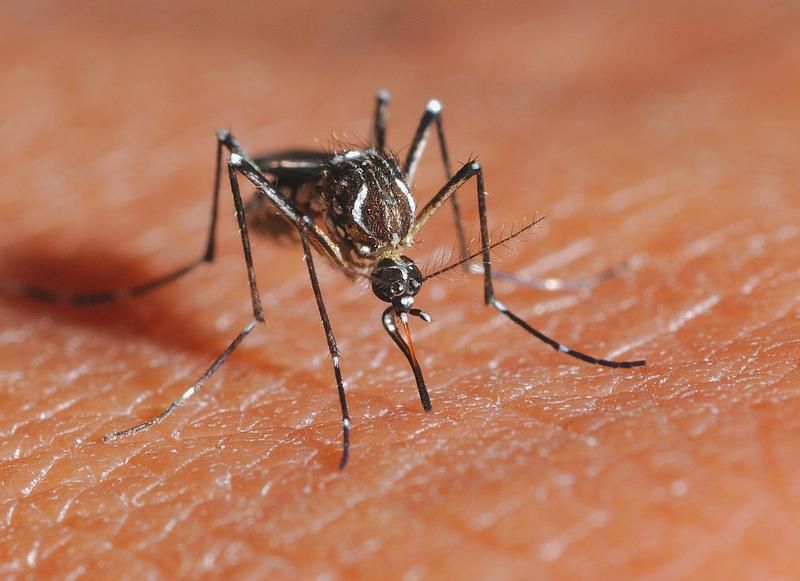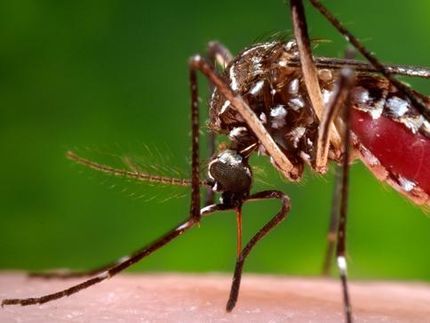Why DEET Keeps Mosquitos and Other Insects at Bay
Chemical agent DEET disorients insects by scrambling their odor receptor apparatus
For decades DEET has been successfully used to repel biting insects. Scientists from Rockefeller University, New York, in collaboration with the Max Planck Institute for Chemical Ecology in Jena, Germany, have now clarified DEET’s (N,N-diethyl-meta-toluamide) mechanism of action. The substance does not block the insects’ recognition of attracting odor signals or cause an active avoidance behavior in mosquitoes and fruit flies, as has been assumed previously. In fact, the substance is such an effective repellent because it disrupts the insects’ odor code. So-called odorant receptors (OR) function to detect special odor signals that enable the insect to locate a potential host or food source. DEET corrupts messages from attractive scents, and as a consequence mosquitoes or fruit flies lose their orientation.

Mosquito (Aedes aegypti) feeding on human skin.
Rickard Ignell, SLU Alnarp, Sweden
Used as a repellent since 1946
The research results achieved by neurobiologists from Leslie Vosshall’s group at Rockefeller University, USA, helped now settle a scientific dispute over DEET's mode of action that has been ongoing for decades. DEET was developed in 1946 as an effective repellent against insect bites and has been used worldwide since. It does, however, neither function as a stimulus blocker nor as an active repellent. The substance, which is only slightly perceptible to humans, is very likely an insect confusant. In collaboration with Bill Hansson and Marcus Stensmyr from the Max Planck Institute for Chemical Ecology in Jena, Germany, who analyzed the odor substances, the scientists elucidated DEET’s mechanism of action by means of modern molecular, neurobiological and chemical techniques.
One neuron, one receptor
The requirements of the experiments fortunately matched the anatomy of the odor reception apparatus. The antenna of the fruit fly Drosophila melanogaster carry sensilla which house olfactory sensory neurons (OSNs) expressing specific odorant receptors (OR). At least two such OSNs are housed in one sensillum. In the experiments, the electric signals of both OSNs were recorded simultaneously and compared to each other. If a selected odor substance, such as linalool, was used as a stimulus, the presence of DEET had a stimulating effect on OSNs expressing receptor Or59b, whereas simultaneously an inhibiting effect on OSNs expressing receptor Or85a could be observed. Altogether, the reactions of four OSNs to ten different odor substances were compared. All substances, except for three, elicited different reactions in the presence of DEET, actually depending on the concentration of the odors in the environment. If no odor substance was used for stimulation, DEET alone did hardly cause any reaction. This means that DEET corrupts the odor code of the insects, which react confused as a result.
Natural variability of odorant receptors as a possible key to DEET’s broad range of activity against different insect species
To decode DEET’s mechanism of action the receptor Or59b was analyzed in more detail. 18 strains of fruit flies, which had been collected in different places of the world, were compared for their reaction to odor stimuli and showed similar results in comparison to the laboratory strain – with the exception of one Brazilian strain: This strain seemed insensitive to DEET and showed different activation patterns to specific odor stimuli. The Or59b encoding gene from the South American strain was compared to the gene from the laboratory strain and showed several deviations in the derived amino acid sequences. Analysis of individual amino acid exchanges using transgenic fruit flies showed that a valine-to-alanine substitution in the Brazilian strain was sufficient to annihilate the effect of DEET – evidence that DEET directly interacts with an odorant receptor and not with the conserved subunits that are also present in the receptor complexes, such as Orco (olfactory receptor coreceptor). The broad repertoire of different ORs in various insect species and their ecotypes may hold the key to the enormously broad range of activity of DEET.
Original publication
Other news from the department science

Get the chemical industry in your inbox
By submitting this form you agree that LUMITOS AG will send you the newsletter(s) selected above by email. Your data will not be passed on to third parties. Your data will be stored and processed in accordance with our data protection regulations. LUMITOS may contact you by email for the purpose of advertising or market and opinion surveys. You can revoke your consent at any time without giving reasons to LUMITOS AG, Ernst-Augustin-Str. 2, 12489 Berlin, Germany or by e-mail at revoke@lumitos.com with effect for the future. In addition, each email contains a link to unsubscribe from the corresponding newsletter.


























































